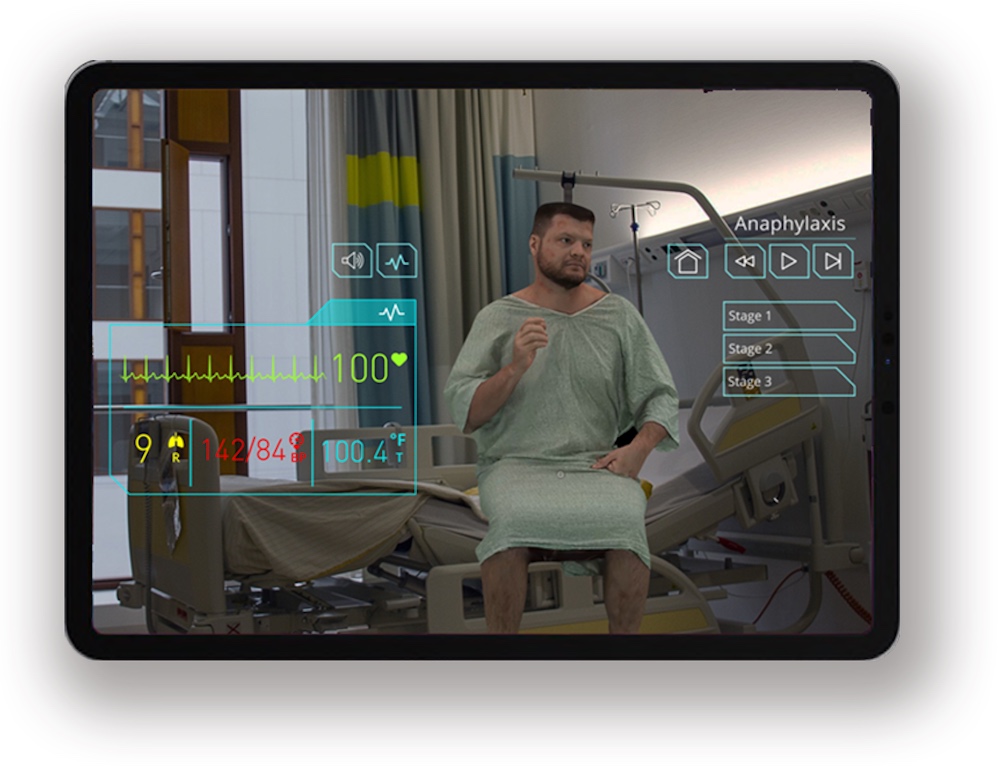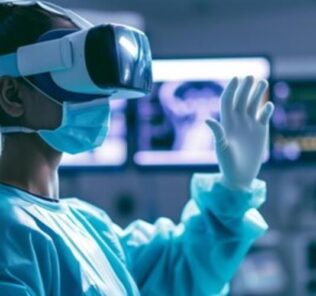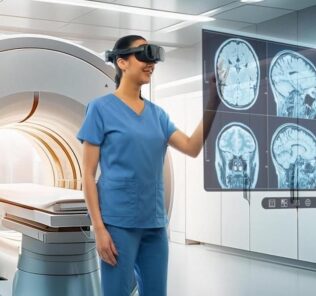GIGXR Helps Nursing Programs Teach Clinical Reasoning, Meet Clinical Simulation Requirements
Helping future nursing professionals master vital skills of observation, diagnosis and treatment has never been more important. Specifically, as clinical placements become more competitive and the overall nursing sector becomes evermore complex and demanding, mixed reality is becoming a critical component of nursing simulation.
GIGXR, a global immersive learning provider, created the HoloPatient app to meet this need. The app uses the Microsoft HoloLens 2 headset and highly realistic holographic video to share 16 different scenarios ranging from anaphylaxis to burns to COVID-19 with learners. This enables them to observe 3 specific cues: visual, aural and vital signs, and subsequently assess and discuss potential treatments to maintain patient care.
Mixed Reality and The Clinical Reasoning Cycle: The holographic content for each pathology can be modified by the instructor to adjust the script GIGXR developed in collaboration with leading subject matter experts. Instructors can also adjust vital signs to accommodate specific curriculum demands. This is especially important because one of the priorities of nursing simulation is to teach learners clinical language, observation, assessment skills using the clinical reasoning model. High-level, this model describes the process of information gathering, observation, assessment, treatment and evaluation that should guide decision-making in nursing.
Sponsored Content:
“Digital technologies are now an established aspect of nursing simulation,” says Emma Collins, principal lecturer in nursing, Otago Polytechnic. “By allowing students to apply theoretical principles in a safe-to-fail environment, HoloPatient and HoloPatient Remote let students humanize their learning experience, both in terms of mastering the use of the clinical reasoning model and of experiencing what it’s like to diagnose and develop treatment suggestions for a ‘real’ patient. With this training, future nurses are able to apply theoretical learning in their very first year of study, giving them more time to master key concepts and providing truly excellent preparation for clinical placements later in the course.”
Tracy Levett-Jones developed a clinical reasoning cycle in response to a tragic real-world problem: Nurses who did not properly intervene when at-risk patients deteriorated. The clinical reasoning cycle is designed to teach nurses to properly identify and act on warning signs that a patient is deteriorating by providing appropriate care at the proper time. Of course, because such warning signs often are as much about visual and verbal interaction (such as unresponsiveness to verbal commands), it is a much easier process to teach when learners have a virtual patient on whom to practice their skills–long before anyone’s safety is in their hands, even as supervised student nurses on clinical placements.
How Mixed Reality Enhances Nursing Simulation: Classroom-based training can also force learners to be overly reliant on data, such as vital signs, which can lead to missing critical clues to the patient’s condition that show up in a visual assessment.
“We can talk about anaphylaxis, but that’s not like actually seeing a patient go into shock,” says Jane Frost, associate professor of nursing at University of Canberra and frequent TEDx speaker. “Similarly, you can have manikins telling you [via a facilitator in another room ‘voicing’ the manikin] that they feel sick, but they can’t demonstrate the symptoms the way HoloPatient does. The tripod position, a recognized position that people adopt when experiencing respiratory distress is often a sign of deterioration in a patient with COPD but is very difficult to simulate. Through Holopatient, you can explore nuances of patient presentations that are hard to replicate in other ways.”
Sponsored Content:
Understanding visual clues is not only key for nursing learners, it’s also a worryingly under-taught skill. For example, in a study Frost co-authored that appeared in the Journal of Clinical Simulation in Nursing, many final-year nursing learners were unable to recognize some physical symptoms of a heart attack.
In the case of many common emergencies, including cardiac emergencies, nurses need to be able to see potential red flags in the patient to provide timely intervention or increased treatment. By showing three stages of each pathology, HoloPatient lets learners observe the outward symptoms of disease progression alongside the changes in vital signs. GIGXR teamed up with global experts in nursing and clinical simulation to write realistic scenarios for the holographic patients.
Mixed reality allows the learners to walk around the holographic patient, which enhances both the realism of the experience and the learners’ observational skills. In a conventional classroom, learners and instructors wear Microsoft HoloLens 2 headsets to observe the patient. For remote or socially distanced learning, students can log into the app from any Android or iOS smartphone or tablet.
Learners can see via their mobile device the same patient the Instructor sees and so instruction is almost identical whether they are in the same room or remote. The learners walk around the patient as it is a 3D experience viewed via their mobile device. Instructors can customize the pathologies shown and alter vital signs and move the patient through stages so learners can compare changes in patients who are deteriorating. The GIG Mobile, remote learning tools. provide great flexibility in delivering instruction for clinical language, observation and assessment in class, in adjacent rooms, across multiple campuses and with learners remotely at home.
Mixed Reality and Clinical Hours Requirements: HoloPatient and HoloPatient Remote fulfill clinical simulation requirements for nursing programs. In the United States, clinical simulation can be credited for up to 50% of clinical hours needed for graduation. During the pandemic, offering remote simulation options is key to ensuring on-time graduation, but the need for cost- and space-efficient simulation will long outlast the challenges of this unprecedented time.
COVID-19 has disrupted simulation activities, but higher education is looking towards the other side of the pandemic. As budgets gradually return to normal, post-pandemic and clinical placements remaining competitive, mixed reality solutions such as HoloPatient and HoloPatient Remote allow nursing programs to keep learners on track for graduation and offer them future-proof training. To meet this demand, GIGXR will continue to expand the number of pathologies available on the HoloPatient app.
More About GIGXR
GIGXR was formed in 2019 to acquire the immersive learning assets of Pearson Education, the world’s leading publisher of educational software. Since then, the company has earned the confidence of Pearson and Microsoft for a total of $5 million in investment and closed an additional $1.3 million in funding. Touted as one of the few XR companies to seek out and meet a real need in the market, the company now has a global roster of leading educational institutions using its flagship application, HoloPatient.
Learn More About GIGXR
References:
- http://www.sciedupress.com/journal/index.php/jnep/article/view/19741/12542
- https://www.sciencedirect.com/science/article/abs/pii/S026069170900210X?via%3Dihub
- https://www.utas.edu.au/__data/assets/pdf_file/0003/263487/Clinical-Reasoning-Instructor-Resources.pdf
- https://www.nursingsimulation.org/article/S1876-1399(20)30016-5/fulltext
Garry Putland is VP of Global Sales, driving international adoption of GIGXR’s 3D, immersive teaching and training tools built for medical, nursing schools and hospitals. Current clients are based in Australia, New Zealand, the UK, Europe, and the US. Putland hails from a deep-rooted career in education, where he has amplified learning through innovative technology at both classroom and senior management roles nationally and globally. Prior to joining GIGXR, Putland was head of global sales for the Immersive Learning division at Pearson, the largest education publisher in the world, and led business development at Education.au a national learning technology company supporting all sectors of Australian education. Putland started his career as a high school STEM teacher in Australia, where he is currently based.
Sponsored Content:






















